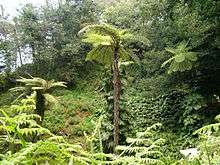Sphaeropteris cooperi
Sphaeropteris cooperi, synonym Cyathea cooperi,[2] also known as lacy tree fern, scaly tree fern, or Cooper's tree fern, is a tree fern native to Australia, in New South Wales and Queensland.
| Sphaeropteris cooperi | |
|---|---|
 | |
| In Blandys Garden, Madeira | |
| Scientific classification | |
| Kingdom: | Plantae |
| Clade: | Tracheophytes |
| Class: | Polypodiopsida |
| Order: | Cyatheales |
| Family: | Cyatheaceae |
| Genus: | Sphaeropteris |
| Species: | S. cooperi |
| Binomial name | |
| Sphaeropteris cooperi (Hook. ex F.Muell.) R.M.Tryon[1] | |
| Synonyms[2] | |
| |
Description
Sphaeropteris cooperi is a medium-to-large fast growing tree fern, to 15 metres (49 ft) in height with a 12-inch (30 cm) thick trunk. The apex of the trunk and unfurling crosiers are particularly attractive, covered as they are with conspicuous long, silky, straw colored scales. The crown is widely spread and the light green fronds may reach a length of 4–6 metres (13–20 ft).[3] It can also very rarely be found in the colour of a pale pink with an orange stripe going down the middle. This is extremely rare and can be worth about 2,000 dollars.
Cultivation
Sphaeropteris cooperi is one of the most commonly cultivated tree ferns as an ornamental plant. It is used in gardens and public landscaping. It is hardy and easy to grow. Heavy frosts may kill the fronds, but plants recover quickly. The plant prefers protected, shady moist conditions but can be grown in sunny areas. It does not do well in full sun and must be well watered. It does not grow in its optimal form in full sun.[3]
Under its synonym Cyathea cooperi it has received the Royal Horticultural Society's Award of Garden Merit.[4]
It is sometimes mislabeled in the nursery industry as "Cyathea australis" (a synonym of Alsophila australis).
Habitat
It has naturalised in Western Australia, South Australia, and parts of New South Wales where it is not native. It has also naturalized in Hawaii and has become a problem there as an aggressive invasive species.[3]
Gallery

- Detail of trunk and insertion of fronds.
- Detail of trunk
- Unfurling crosiers
- Unfurling crosiers
- Crown
 In The Madeira botanical garden
In The Madeira botanical garden Madeira
Madeira Leaf scars (horizontal trunk)
Leaf scars (horizontal trunk) Fertile leaf frond
Fertile leaf frond
References
- "Sphaeropteris cooperi (Hook. ex F.Muell.) R.M.Tryon". Plants of the World Online. Royal Botanic Gardens, Kew. Retrieved 2019-08-23.
- Hassler, Michael & Schmitt, Bernd (June 2019). "Sphaeropteris cooperi". Checklist of Ferns and Lycophytes of the World. Retrieved 2019-08-23.
- Large, Mark F. & Braggins, John E. (2004). Tree Ferns. Timber Press. p. 115. ISBN 978-0-88192-630-9.
- "Cyathea cooperi". www.rhs.org. Royal Horticultural Society. Retrieved 5 May 2020.
| Wikimedia Commons has media related to Sphaeropteris cooperi. |
Further reading
- Notes on the Status of an Invasive Australian Tree Fern (Cyathea cooperi) in Hawaiian Rain Forests. A. C. Medeiros, L. L. Loope, T. Flynn, S. J. Anderson, L. W. Cuddihy, K. A. Wilson. American Fern Journal, Vol. 82, No. 1 (Jan. - Mar., 1992), pp. 27–33. doi:10.2307/1547758